Yes, You Can Quantify Change Management's Value

5 Mins
Updated: October 28, 2025
Published: February 1, 2023

Change practitioners often struggle to measure the contribution of change management to the success of a change in a tangible way. The factors contributing to the struggle include lack of alignment on the definition of success, not establishing specific success metrics, and failing to collect the necessary data. These struggles contribute to the misconception that the value of change management can’t be measured. By following Prosci’s holistic approach, you can quantify and measure the contribution of change management to benefits realization for the change initiatives you are supporting.
Step 1: Start by Defining Success
The critical first step for measuring the contribution of change management to benefits realization is defining success for your change initiative. The Unified Value Proposition illustrates how change management and project management are complementary disciplines with a common objective of achieving success for a change initiative.
Prosci's Unified Value Proposition

The focus of the technical side (project management) is to design, develop and deliver the solution to a problem or to address an opportunity. But, if you focus only on the technical side, you will simply install a change.
The people side (change management) involves engaging the individuals and groups impacted by the change in the process of designing, developing and delivering the solution, and supporting them to be able to adopt and use it in their daily work.
If you focus on both the technical and people sides of a change, you can achieve success, which we define as meeting or exceeding the project objectives and realizing organizational benefits.
Roles in defining success
The primary sponsor of the change and the change practitioner have distinct roles in defining and ensuring success. The primary sponsor is accountable for explaining why the change is needed and defining what success looks like in terms of the project objectives (what the project will achieve) and organizational benefits (what the organization gains).
The change practitioner extracts and packages the definition of success by asking great questions, including:
- “Why do we need to change?”
- “What is the problem or opportunity for the organization?”
- “What are the benefits the organization is seeking from this change?”
- “How would we know that the project is achieving what is expected?”
To package your definition of success, Prosci recommends using the 4P’s Exercise, which enables you to show on a single piece of paper the connection between the project, its purpose and intended outcomes, the particulars of the change, and the people who will be impacted. It’s a great tool for capturing, documenting and communicating the definition of success.
Step 2: Determine the People-Dependent Portion of ROI
The next step is to quantify adoption—and adoption of a change can indeed be quantified. It's the portion of the total return on investment (ROI) for the change that results from people adopting and using the solution in their daily work.
Consider two simple projects to illustrate the people-dependent portion of ROI. Project 1 involves installing motion-activated lights in meeting rooms. Project 2 involves installing combination trash, recycling and composting bins that include all three waste streams.
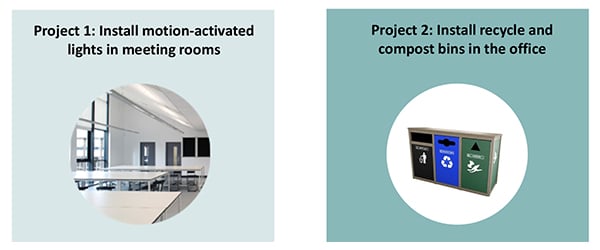
For Project 1, the people-dependent portion of ROI would essentially be zero because the meeting room lights will automatically turn on or turn off as people enter or leave a room. In contrast, for Project 2, the people-dependent portion of ROI would be significant, probably 75% or more. Why? Because the efficient use of the combination bins requires people to put their waste items in the appropriate bin, i.e., they must change their behavior compared to just using a garbage can to ensure that the benefits are realized.
How to calculate people-dependent ROI for your unique change
To determine the people dependent portion of ROI, ask your primary sponsor and other key stakeholders to estimate the percentage of overall results and outcomes that depends on employee adoption and usage.
Next, ask them this important follow-up question: “What percentage of the project budget has the organization committed to driving and supporting employee adoption and usage of the change?”
The Key Questions to Ask Leaders
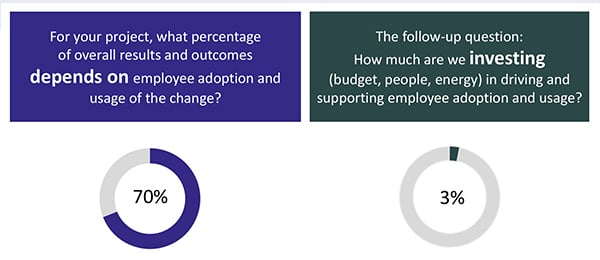
Identifying the gap between these two percentages enables you to have deeper conversations with your leaders about the need to invest in the people side of change to capture the people-dependent portion of the project ROI.
Step 3: Understand What, How and When to Measure
Once success has been defined and the change is underway, it’s time to start the work of measuring performance.
What to measure
Organizational outcomes are the collective result of individual change. To capture this, Prosci measures performance on three levels:
- Organizational performance
- Individual performance
- Change management performance
Organizational and individual performance measure outcomes, while change management performance measures activities.
3 Performance Levels
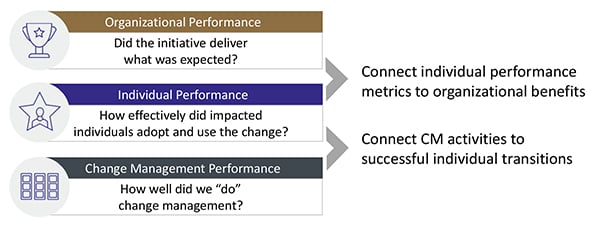
The three performance levels are interdependent and provide a holistic framework for measuring performance. When we assess performance, we start with Change Management Performance and move up to Organizational Performance, asking specific questions at each level:
- Change Management Performance – The question we ask when assessing change management performance is, “How well did we do change management?” When we do change management well, we prepare, equip and support people to adopt and use a change in their daily work.
- Individual Performance – The question we ask to assess individual performance is, “How effectively did impacted individuals adopt and use the change?” When we reach a critical mass of people adopting and using the change proficiently, we begin to realize organizational benefits.
- Organizational Performance – The question we ask to assess organizational performance is, “Did the initiative deliver what was expected?” Success means meeting or exceeding the project objectives and realizing organizational benefits that are sustainable over time.
How to measure
Measuring performance requires specific actions at each of the three levels.
- Measuring change management performance – involves tracking progress and reporting status in implementing change management plans over the lifecycle of the project. It also means assessing the extent to which change management best practices are being applied. Most change practitioners are familiar with tracking and reporting for this performance level.
- Measuring individual performance – involves using the ADKAR Model to assess individual and group progress in achieving successful transitions through the five elements which comprise the model. We determine the outcomes of those transitions—that is, how effectively individuals have adopted and are using the change—by measuring speed of adoption of the change (how quickly), ultimate utilization (how many) and proficiency (how well). The specific metrics you select for each of these three human factors will be unique to your change.
- Measuring organizational performance – requires assessing progress in meeting project objectives, and achieving and sustaining organizational benefits. The primary sponsor, project manager and change practitioner have specific responsibilities in measuring organizational performance.
It is the responsibility of the change practitioner to monitor overall project health using the Prosci Change Triangle (PCT) Model. The PCT Model enables the change practitioner to measure the four critical aspects of any successful change effort: a shared definition of success, strong leadership/sponsorship, and effective project management and change management.
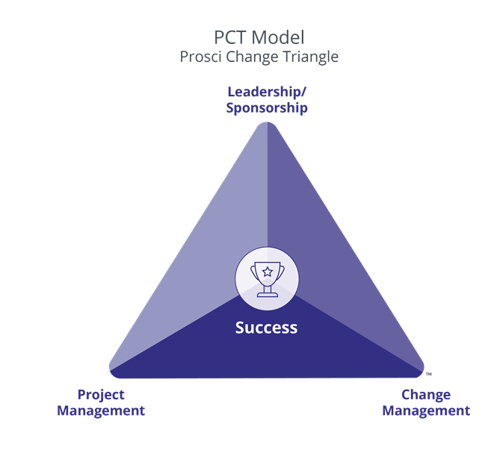
The addition of the success aspect in the center of the triangle is one of the key enhancements to the Prosci Methodology in 2021. It enables you to assess, at project initiation, if your primary sponsor and key stakeholders are aligned around a common definition of success. If the assessment reveals misalignment, you have the information necessary to facilitate the discussions required to resolve any differences and establish a common understanding of what success should look like for the change.
The PCT Assessment is also a leading indicator of the potential for the success of a change. The information gained from repetitive applications of the assessment can be used to determine whether you require corrective actions to keep your change on track. The PCT Assessment can help you understand strengths to amplify, risks to address, and other factors that require investigation and potential corrective action in conjunction with your primary sponsor, project manager, or other key stakeholders.
When to measure
Using the Prosci Change Triangle (PCT) Assessment, you can track and monitor overall project health throughout the project lifecycle. You should conduct multiple PCT Assessments, starting at project kickoff and then at major project milestones, such as the go-live date and the date when project outcomes are expected to be sustained.
To track individual performance using the ADKAR Assessment, you need to map the achievement of the five elements of ADKAR to specific milestones in your project’s lifecycle. With a sequential project management approach (often described as waterfall), you map the achievement of Ability with the go-live date to ensure that impacted individuals and groups are able to adopt and use the solution when it is provided to them.
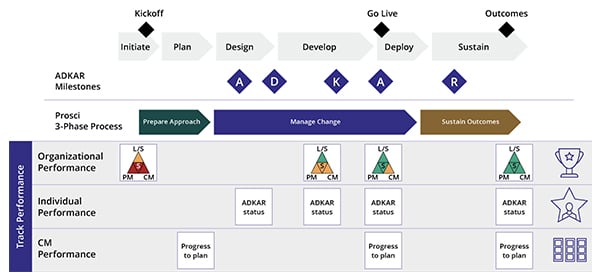
Sequential Approach
When using an iterative project management approach (such as Agile), you need to align the achievement of the Knowledge and Ability elements with each release, so members of impacted groups are equipped to adopt and use the associated solutions. If you are using an iterative approach for your change, you will need to do more ADKAR Assessments than you would when using a sequential approach.
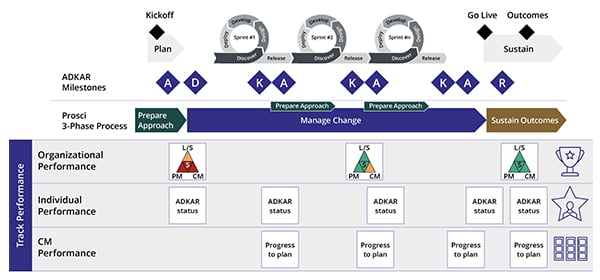 Iterative Approach
Iterative Approach
Measure and Communicate Change Management’s Value
As change practitioners, we see the value change management brings to change initiatives every day. But demonstrating that value to your primary sponsor takes work—ensuring a common definition of success, establishing quantifiable measures that they understand and accept, and measuring performance over the lifecycle of your project. When used together, the 4P’s Exercise, Three Levels of Performance, PCT Assessment, and the ADKAR Assessment provide a holistic approach that will enable you to measure and demonstrate the clear contribution change management makes to benefits realization for your change.




